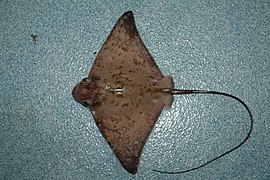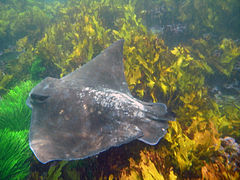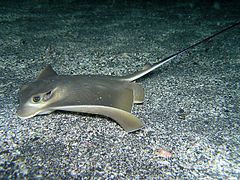Myliobatis
| Myliobatis | |
|---|---|

| |
| Myliobatis californica | |
| Scientific classification | |
| Kingdom: | Animalia |
| Phylum: | Chordata |
| Class: | Chondrichthyes |
| Order: | Myliobatiformes |
| Family: | Myliobatidae |
| Genus: | Myliobatis Cuvier, 1816 |
| Species | |
|
See text | |
Myliobatis is a genus of eagle rays in the family Myliobatidae.
Description[]
Myliobatis species can reach a width up to about 1.8 m (6 ft).[2] Their bodies consist of a rhomboidal disc, wider than long, with one dorsal fin. The head is broad and short, with eyes and spiracles on the sides. The tail is slender, with one or two large spines at the base, without tail fin.[3]
The teeth are arranged in the lower and upper jaws in flat tooth plates called pavement teeth, each consisting of about seven series of plates, which are used to crush clam shells and crustaceans.[3]
Biology[]
Myliobatis species are ovoviviparous. Their gestation last about 6 months and a female produces four to seven embryos. Myliobatis species mainly feed on molluscs, bottom-living crustaceans, and small fishes.[4]
Habitat[]
Mylobatis species live in warm, shallow waters. Adults prefer sandy shores, while juveniles can usually be encountered offshore.[3][4]
Species[]
Extant species[]
Currently, 11 species in this genus are recognized:[2][5]
| Image | Scientific name | Common Name | Distribution |
|---|---|---|---|
 |
Myliobatis aquila (Linnaeus, 1758) | common eagle ray | Atlantic Ocean (North Sea to South Africa), the Mediterranean Sea and the south-western Indian Ocean. |
| Myliobatis australis , 1981 | Australian bull ray | Eastern Indian Ocean: southern Australia, from Western Australia to Queensland.[6] | |
 |
Myliobatis californica T. N. Gill, 1865 | bat eagle ray | eastern Pacific Ocean, between the Oregon coast and the Gulf of California. |
 |
Myliobatis chilensis Philippi {Krumweide}, 1893 | Chilean eagle ray | coasts of Chile and Peru |
 |
Myliobatis freminvillei Lesueur, 1824 | bullnose eagle ray | from Cape Cod down to Argentina |
 |
Myliobatis goodei Garman, 1885 | southern eagle ray | Atlantic coast, from the tip of Florida down to Argentina |
 |
Myliobatis hamlyni J. D. Ogilby, 1911 | purple eagle ray[7] | Australia, Indonesia, the Philippines, Taiwan and Okinawa |
| Myliobatis longirostris & , 1964 | snouted eagle ray | Pacific Ocean from Baja California and the Gulf of California to Sechura, Peru | |
| Myliobatis peruvianus Garman, 1913 | Peruvian eagle ray | Pacific Ocean off Chile and Peru. | |
| Myliobatis ridens , , , & , 2012 | shortnose eagle ray[8] | southwestern Atlantic Ocean off Brazil and Argentina. | |
 |
Myliobatis tenuicaudatus Hector, 1877 | Australian/New Zealand eagle ray | near rocky reefs around New Zealand and southern Australia |
 |
Myliobatis tobijei Bleeker, 1854 | Japanese eagle ray[7] | Indonesia and the Philippines,Japan, Korea, and China. |
Extinct species[]

Extinct species within this genus include:[9]
- † Agassiz, 1843
- † Chapman & Cudmore, 1924
- † Pauca, 1929
- † Meschinelli, 1924
- † Davis, 1888
- † Bravard, 1884
- † Sismonda, 1849
- † Agassiz, 1843
- † Davis, 1888
- † Issel, 1877
- † Dartevelle & Casier, 1943
- † Marsh, 1870
- †Myliobatis bothriodon White, 1926
- † Agassiz, 1843
- † Agassiz, 1843
- † Dartevelle & Casier, 1959
- † Delfortrie, 1871
- † Leriche, 1913
- † Agassiz, 1843
- † Stromer, 1905
- † Mendiola, 1999
- † Salinas, 1901
- † Leidy, 1876
- † Stromer, 1905
- † Eastman, 1904
- † Delfortrie, 1871
- † Cope, 1867
- † Pedroni, 1844
- † Agassiz, 1843
- † Issel, 1877
- † Penecke, 1884
- † Gibbes, 1849
- † Dartevelle & Casier, 1943
- † Fowler, 1911
- † Thomas, 1904
- † Agassiz, 1843
- † Hay, 1899
- † Delfortrie, 1871
- † Dartevelle & Casier, 1959
- † Bauzá & Gomez Pallerola, 1982
- † Leidy, 1876
- † Agassiz, 1843
- † Jordan & Beal, 1913
- † Weiler, 1922
- † Agassiz, 1843
- † Delfortrie, 1871
- † Böhm, 1942
- † Stromer, 1905
- † Cappetta, 1986
- † Chapman & Pritchard, 1907
- † Leidy, 1876
- † Dartevelle & Casier, 1959
- † Dartevelle & Casier, 1943
- † Agassiz, 1843
- † Cope, 1867
- † Fowler, 1911
- † Woodward, 1893
- † Carraroli, 1897
- † Davis, 1888
- † Chapman & Cudmore, 1924
- † Arambourg, 1952
- † Meyer, 1844
- † Sauvage, 1878
- † Leidy, 1855
- † Botti, 1877
- † Mendiola, 1999
- † Hatai, Murata & Masuda, 1965
- † Meyer, 1843
- † Deraniyagala, 1937
- † Agassiz, 1843
- † Buckland, 1837
- † Issel, 1877
- † Philippi, 1846
- † Mishra, 1980
- † Agassiz, 1843
- † Gibbes, 1849
- † Woodward, 1889
- † Chaffee, 1939
- † Cope, 1867
- † White, 1934
These eagle rays lived from the Cretaceous to the Quaternary periods (from 70.6 to 0.012 Ma). Fossils of these fishes have been found worldwide.[9]
The extinct species is known from Tertiary deposits along the Atlantic seaboards of the United States, Brazil, Nigeria, England, and Germany.[9]
Gallery[]

M. aquila

M. californica

M. freminvillei

M. tenuicaudatus

M. tobijei
See also[]
- List of prehistoric cartilaginous fish
References[]
- ^ Sepkoski, J. (2002). "A compendium of fossil marine animal genera (Chondrichthyes entry)". Bulletins of American Paleontology. 364: 560. Archived from the original on 2012-05-10.
- ^ a b Froese, Rainer and Pauly, Daniel, eds. (2017). Species of Myliobatis in FishBase. July 2017 version.
- ^ a b c Discover life
- ^ a b World Register of Marine Species
- ^ White, W.T. (2014). "A revised generic arrangement for the eagle ray family Myliobatidae, with definitions for the valid genera". Zootaxa. 3860 (2): 149–166. doi:10.11646/zootaxa.3860.2.3. PMID 25283197.
- ^ "Myliobatis australis | Shark-References".
- ^ a b White, W.T.; Kawauchi, J.; Corrigan, S.; Rochel, E.; Naylor, G.J.P. (2015). "Redescription of the eagle rays Myliobatis hamlyni Ogilby, 1911 and M. tobijei Bleeker, 1854 (Myliobatiformes: Myliobatidae) from the East Indo-West Pacific". Zootaxa. 3948 (3): 521–548. doi:10.11646/zootaxa.3948.3.7. PMID 25947786.
- ^ Ruocco, N.L.; Lucifora, L.O.; de Astarloa, J.M.D.; Mabragaña, E.; Delpiani, S.M. (2012). "Morphology and DNA barcoding reveal a new species of eagle ray from the Southwestern Atlantic: Myliobatis ridens sp. nov. (Chondrichthyes, Myliobatiformes, Myliobatidae)" (PDF). Zoological Studies. 51 (6): 862–873.[permanent dead link]
- ^ a b c Shark References
Further reading[]
- Aguiar, A.A.; Gallo, V.; Valentin, J.L. (2004). "Using the size independent discriminant analysis to distinguish the species of Myliobatis Cuvier (Batoidea: Myliobatidae) from Brazil". Zootaxa. 464: 1–7. doi:10.11646/zootaxa.464.1.1.
- Compagno, L.J.V. (1999): Checklist of living elasmobranchs. A: Hamlett W.C. (ed.) Sharks, skates, and rays: the biology of elasmobranch fishes., The Johns Hopkins University Press: 471-498.
- Garman, S (1913). "The Plagiostomia (Sharks, Skates and Rays)". Memoirs of the Museum of Comparative Zoology. 36: 1–515.
- Gill, T.N. (1865). "Note on the family of myliobatoids, and on a new species of Aetobatis". Annals of the Lyceum of Natural History of New York. 8: 135–138. doi:10.1111/j.1749-6632.1867.tb00300.x.
- Walker, C. & Ward, D. (1993): - Fossielen: Sesam Natuur Handboeken, Bosch & Keuning, Baarn. ISBN 90-246-4924-2
- Myliobatis
- Ray genera
- Taxa named by Georges Cuvier




